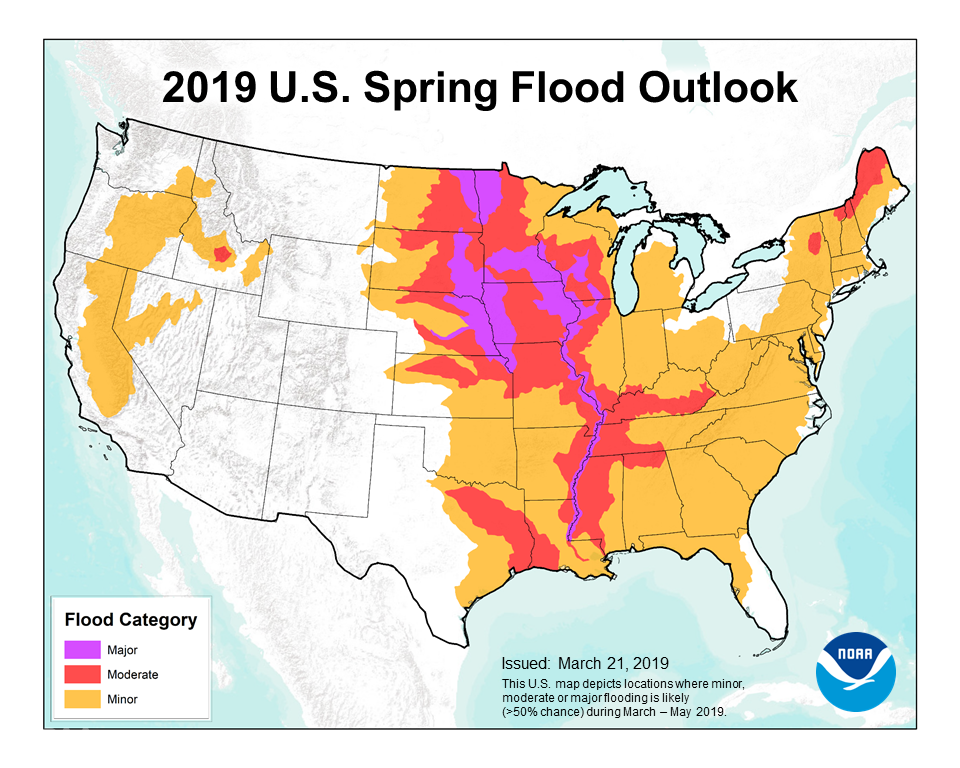“R” is for Rain and Runoff – More to Come
When I teach about the unprecedented threat of rising sea level, I put it in the context of “The 5 Flood Factors”:
- Storms
- Rain
- Runoff
- Extreme Tides
- Sea Level Rise
The last two are of course limited to coastal areas and tidal rivers. Most people dismiss “runoff” since it seems so related to rain. However, the recent runoff on land and downstream flooding in the American mid-west demonstrates that it can be the most powerful of all. Rainfall is obviously what comes out of the atmosphere. Runoff is determined by amount of rain, the area of rain, and the local topography.
The U.S. farm belt declared more than a billion dollars of damage last week from flooding. Throughout the mid-West record rain and downstream runoff devastated farmland, ruined crops and killed hundreds of thousands of cattle. Many farmers indicated they had reached their limit.
A feature story in the New York Times on Sunday, “Breaches Everywhere’: Flooding Bursts Midwest Levees, and Tough Questions Follow” quoted Nebraska farmer Roger Ideker to say:
“Our levees are big and they’re good,” but they were no match for this new normal. “Every event seems like it’s higher. It’s higher water. You build the levee higher. And the next time you build it higher. You can’t keep up with it.”
Runoff is the stealth factor. As the ground saturates, the runoff moves downhill and downstream. “Downhill” can be down a steep valley, or down an imperceptible slope of apparently flat plains and farmland. Due to runoff, the water will accumulate in areas of lower elevation, to far greater depths than the rainfall itself. In the last two weeks there has been record runoff. In fact, we are seeing record floods all over the world, notably India, the Philippines, and China, just to name a few.
Though perhaps surprising, extreme rainfall is occurring along with extreme drought and even make runoff worse. Climate experts fully predicted this as the oceans and continents get warmer. Hotter weather can cause drought as the land warms. Soils can become “baked” losing porosity. Warmer oceans cause more evaporation. That extra moisture in the atmosphere has to come down as rain, or snow – if the local temperature is below freezing.
As the very clear Spring Flood Outlook map above from NOAA shows, the worst may be yet to come. In the next month or so, flooding from added spring rains and runoff from the melting snowpack, could make things even more severe. Snowpack in northern California and Colorado reached record levels, as much as five feet.
Of course, the immediate focus with these floods is on rescues and getting people back to their farms and homes as soon as possible. But the attention is also on the levee system, the US Army Corps of Engineers, and public policy in an era of obviously changing weather patterns, whether someone wants to refer to it as climate change or not – but increasingly those affected are making the connection.
This era of extraordinary flooding should force us to rethink policies of floodplains and levees. As an example, for a thousand years the Dutch built levees (dikes) to push back the water. They were famous for the technology. Now, even they have come to recognize limits on what is realistic. There are limits to levees, in the new era, with record-setting rainfall and runoff. “Room for the River” is their rather new concept. It engineering areas for the rivers to overflow their banks, flooding designated farmland, but saving homes and communities.
It is a great example that old models need to be re-thought. In an era when historic hundred year storm events are happening every few years, basic engineering concepts like the size of drainage pipes and seepage areas need to be re-examined. Architecture, engineering, planning, emergency preparedness, finance and law all must re-examine that which was taken for granted.
It is good that FEMA is finally looking to update its flood risk model; in fact, long overdue. It’s also great that private sector firms like Jupiter Intelligence are creating next generation flood risk models advancing forecasting precision by an order of magnitude. (Full disclosure: I am an advisor to them.) We need new tools and new policies. As that New York Times article documents, our farmers recognize we are in a new era. Like the Dutch we need to recognize that water management, real estate development and agriculture need to change as climate changes.
Usually I would try to end with some humor, perhaps about wading boots, but this is not a humorous situation. These floods are deadly. They destroy lives, farms, and communities. The effects of droughts and floods will affect agriculture and food production, affecting all of us in the form of supermarket prices. Welcome to the new normal as Mr. Ideker noted. It is critical that we begin adapting to a new level of flooding, while we simultaneously reduce the record level of greenhouse gases that has clearly been associated with the changing climate.

